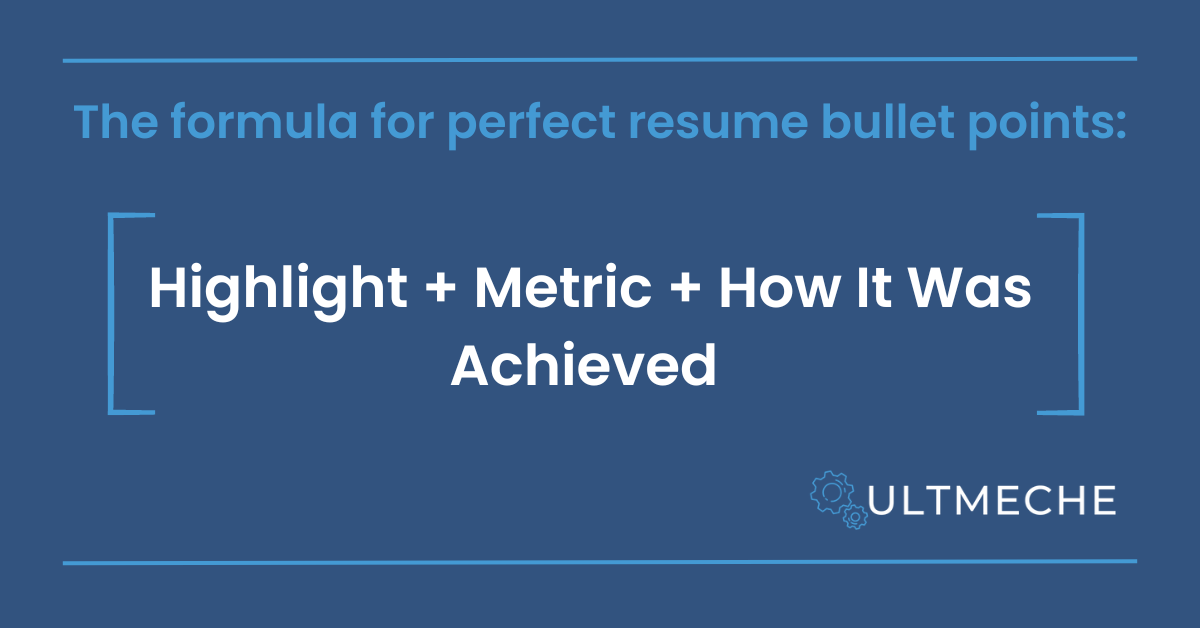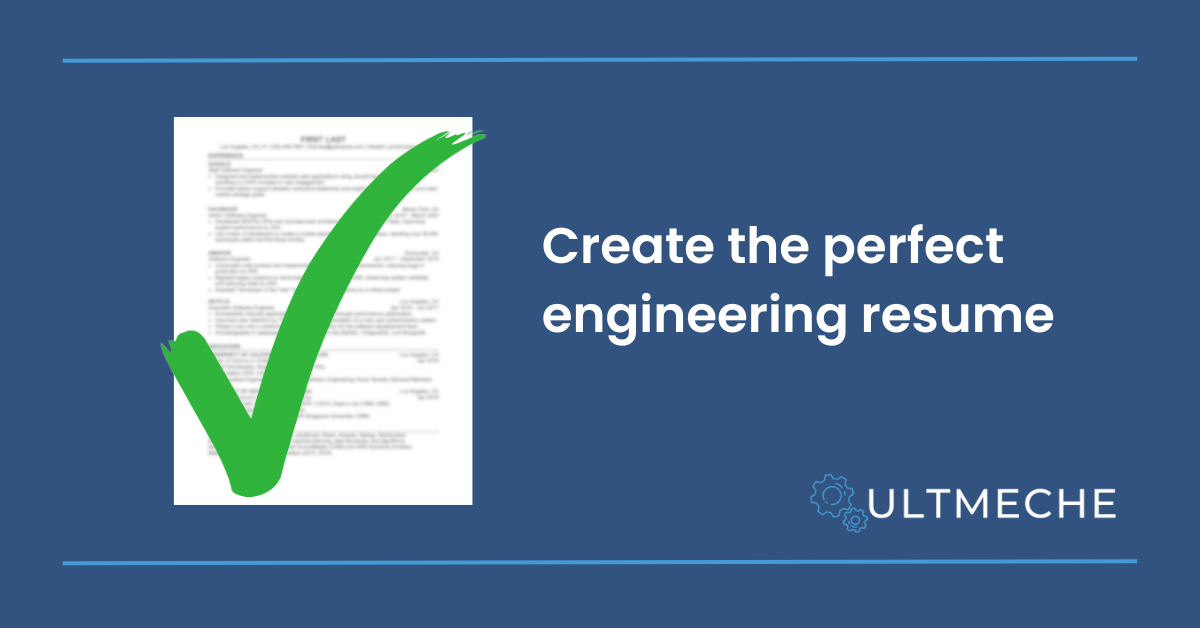Creating an excellent manufacturing engineer resume template can take time, but it will make all the difference when you’re trying to stand out in a competitive job market.
A well-crafted resume ensures that hiring managers don’t overlook your skills and experience amidst the flood of applicants.
But what is it that makes a manufacturing engineer resume truly exceptional?
This guide breaks down how you can create your own manufacturing engineer resume template so that by the end, you’ll have a flexible and customisable template that properly showcases your skills and expertise.
Don’t have time to create your own? Get our professional template right away.

Why is a Manufacturing Engineer Resume Template So Important?
Too often, applicants don’t realize the value of a tailored resume. Being able to quickly and effectively personalize your application is essential for landing the best roles.
Follow these steps to build a professional manufacturing engineer resume.
Step 1: Structuring Your Resume for Maximum Impact
A strong resume needs to be well-structured and properly formatted.
A good layout allows recruiters to quickly identify the most important information without having to read everything in detail.
Different employers might prefer specific layouts like a Harvard resume format or Google’s XYZ template. Researching the business is the best way to identify any trends or preferences.
Tips for Formatting Your Manufacturing Engineer Resume:
Here’s how to ensure your resume is clear and simple to navigate:
- Professional Design: Choose a straightforward, professional look. Avoid excessive graphics or complex layouts that could disrupt the Applicant Tracking Systems (ATS) used by the hiring business.
- Simple Fonts: Opt for clean fonts like Helvetica or Times New Roman, keeping the font size consistent and clear.
- Adequate Spacing: Use clear margins and space out sections to improve readability.
- PDF Format: Save your resume as a PDF to maintain your formatting.
- Reverse Chronological Order: List your work experience and education starting with the most recent.
- Clear Section Headings: Use simple section titles like “Experience,” “Education,” and “Skills” for easy, clear navigation.
- Use Bullet Points: Present your achievements with bullet points, making them concise and easy to skim.
Tip: Incorporate keywords from the job description to ensure your resume aligns with what the employers are seeking.
Step 2: Highlighting Your Contact Information
When you begin to write your resume, your contact details should be clear and immediately visible at the top, making it straightforward for recruiters to reach you.
Be sure to include all of the following information:
- Full Name: Ensure your full name is the most visible element.
- Phone Number: Provide a reliable contact number.
- Professional Email: Use a professional email address—something simple like firstname.lastname@mail.com
- LinkedIn Profile (Optional): If you have an up-to-date LinkedIn profile that highlights your skills, include a link.
- Portfolio Link (Optional): If you have a portfolio showcasing projects or case studies, include a link for easy access.
Step 3: Showcasing Your Professional Experience
This section is the backbone of your resume. Here, you should clearly outline your responsibilities, technical know-how, and highlight the contributions you’ve made in previous roles.
How to Structure Your Experience Section
- Company Details: Include the company name and location for each role.
- Job Title: State your exact job title.
- Employment Duration: Use months and years to show the period you were in each position.
- Key Achievements: Use bullet points to focus on your main achievements. Emphasize outcomes and results related to the job you’re applying for.
How To Craft Impactful Bullet Points For Your Resume:

Each point should highlight a specific contribution or accomplishment.
- Use Strong Verbs: Begin each point with powerful verbs like “Implemented,” “Optimised,” or “Engineered.” Show your impact.
- Include Metrics: Where possible, quantify results to illustrate your impact (e.g., “Boosted production speed by 25%” or “Reduced material waste by 12%”).
- Tailor to the Role: Adjust bullet points to showcase the skills most relevant to the job you’re pursuing. Having tailored content for each application can make a significant difference when the hiring manager is looking at multiple resumes.
EXAMPLE:
TESLA
Manufacturing Engineer IV
Las Vegas, NV
Mar 2022 – Present
- Oversaw the design and production volume of 100K+ vehicles per quarter, achieving an 86% on-time delivery to customers
- Provided liaison support between executive leadership and engineering teams to target and meet market strategy goals
Step 4: Detailing Your Education
Your education and qualifications are often essential for manufacturing roles, particularly for those requiring technical knowledge in engineering fields.
Be sure to include the following in this section:
- Institution: List the full name of the university or training institution.
- Degree: Mention your full degree title.
- Graduation Date: Include the month and year of graduation.
- Notable Courses or Honors: Highlight coursework or distinctions relevant to the role, especially those that demonstrate specialized knowledge.
EXAMPLE:
UNIVERSITY OF CALIFORNIA AT LOS ANGELES
Master of Science in Mechanical Engineering with Honors
Los Angeles, CA
Apr 2018
- XXX Scholarship, Director’s List 2018 (top 10%)
- Cumulative GPA: 3.93/4.0 (Include if 3.0+)
- Aeronautical Engineering Club (Board Member), Engineering Honor Society (General Member)
Step 5: Adding Additional Skills and Certifications
In the final section, highlight the skills, certifications, and achievements that make you a strong candidate. This is an opportunity to showcase your technical abilities and dedication to continued professional development.
Key Details to Include:
- Technical Skills: Outline your expertise in relevant software, tools, and manufacturing systems.
- Certifications: List certifications like AUTOCAD or ProEngineer that enhance your profile.
- Professional Memberships: Include memberships in engineering or manufacturing associations.
- Languages: Highlight any additional languages that could be beneficial in a global manufacturing environment.
EXAMPLE
ADDITIONAL
- Technical Skills: Advanced in CAD (PTC Creo 3.0, ProEngineer, Siemens NX, SolidWorks, AutoCAD), JavaScript, HTML/CSS; Proficient in MATLAB, Python, CPLM, SAP
- Languages: Fluent in French, English; Conversational Proficiency in Japanese
- Certifications & Training: SolidWorks, AutoCAD, ProEngineer
- Awards: Dean’s List Multiple Semesters
Get Your Manufacturing Engineer Resume Template

Creating a standout manufacturing engineer resume template doesn’t have to be a lengthy process.
By following these guidelines, you can develop a professional resume that highlights your skills and experience, giving you an edge in the hiring process.
Whether you’re applying to major companies or smaller manufacturing firms, a strong resume will help you make a great impression.
Download your professional resume template here.
About the author

Mollie Buttery
Writer | SEO | Articles & Blog Posts | Social Media
Mollie supports ULTMECHE through website growth, social media, SEO, and also other digital marketing tricks. Mollie has 10+ years experience of in house and freelance marketing experience in industries such as Finance, Law, SAAS, Automotive, Building Services, Commerce, and more. Some of her favorite writing topics consist of sports and finance. Mollie has been key to the growth of ULTMECHE’s SEO and digital marketing efforts.
